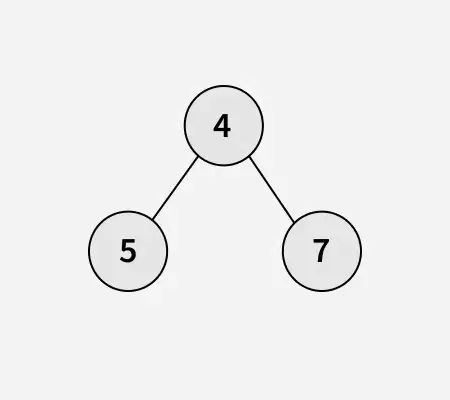Dado um árvore n-ária contendo valores de nós positivos, a tarefa é encontrar o profundidade da árvore.
Observação: Um árvore n-ária é uma árvore onde cada nó pode ter zero ou mais nós filhos. Ao contrário de uma árvore binária que possui no máximo dois filhos por nó (esquerda e direita) a árvore n-ária permite múltiplas filiais ou filhos para cada nó.
Exemplos:
Entrada:
Saída: 3
Explicação: O caminho mais longo da raiz (nó 81) até uma folha é 81 -> 26 -> 95 ou 81 -> 26 -> 86, dando uma profundidade máxima de 3.Entrada:

Saída: 2
Explicação: O caminho mais longo da raiz (nó 4) para qualquer folha (nós 5 ou 7) é 2, pois requer apenas dois níveis de travessia.verifique se há nulo em java
Abordagem:
A ideia é calcular profundidade de uma árvore N-ária recursivamente inicializar o profundidade máxima como 0, então calcule recursivamente o profundidade para cada criança e acompanhar o maior profundidade encontrado. Finalmente adicione 1 para a profundidade máxima (para o nó atual) e retornar o resultado . Esta abordagem garante que encontraremos o caminho mais longo da raiz a qualquer nó folha.
A árvore N-Ary pode ser percorrida como uma árvore normal. Só temos que considerar todos os filhos de um determinado nó e chamar recursivamente essa função em cada nó.
C++// C++ Code to find the depth of an N-ary tree #include
// Java Code to find the depth of an N-ary tree import java.util.*; class Node { int data; List<Node> children; Node(int val) { data = val; children = new ArrayList<>(); } } // Recursive function to calculate // maximum depth class GfG { static int maxDepth(Node root) { // If the node is null depth is 0 if (root == null) { return 0; } int depth = 0; // Recur for all children and find // the maximum depth for (Node child : root.children) { depth = Math.max(depth maxDepth(child)); } // Add 1 to include the current node // in the depth count return depth + 1; } public static void main(String[] args) { // Representation of given N-ary tree // 1 // / | // 2 3 4 // / // 5 6 Node root = new Node(1); root.children.add(new Node(2)); root.children.add(new Node(3)); root.children.add(new Node(4)); root.children.get(0).children.add(new Node(5)); root.children.get(2).children.add(new Node(6)); System.out.println(maxDepth(root)); } }
# Python Code to find the depth # of an N-ary tree class Node: def __init__(self val): self.data = val self.children = [] # Recursive function to calculate # maximum depth def max_depth(root): # If the node is None depth is 0 if not root: return 0 depth = 0 # Recur for all children and # find the maximum depth for child in root.children: depth = max(depth max_depth(child)) # Add 1 to include the current # node in the depth count return depth + 1 if __name__ == '__main__': # Representation of given N-ary tree # 1 # / | # 2 3 4 # / # 5 6 root = Node(1) root.children.append(Node(2)) root.children.append(Node(3)) root.children.append(Node(4)) root.children[0].children.append(Node(5)) root.children[2].children.append(Node(6)) print(max_depth(root))
// C# Code to find the depth of an N-ary tree using System; using System.Collections.Generic; class Node { public int data; public List<Node> children; public Node(int val) { data = val; children = new List<Node>(); } } // Recursive function to calculate // maximum depth class GfG { static int MaxDepth(Node root) { // If the node is null depth is 0 if (root == null) { return 0; } int depth = 0; // Recur for all children and find the maximum depth foreach (Node child in root.children) { depth = Math.Max(depth MaxDepth(child)); } // Add 1 to include the current // node in the depth count return depth + 1; } static void Main(string[] args) { // Representation of given N-ary tree // 1 // / | // 2 3 4 // / // 5 6 Node root = new Node(1); root.children.Add(new Node(2)); root.children.Add(new Node(3)); root.children.Add(new Node(4)); root.children[0].children.Add(new Node(5)); root.children[2].children.Add(new Node(6)); Console.WriteLine(MaxDepth(root)); } }
// JavaScript Code to find the depth // of an N-ary tree class Node { constructor(val) { this.data = val; this.children = []; } } // Recursive function to calculate // maximum depth function maxDepth(root) { // If the node is null depth is 0 if (!root) { return 0; } let depth = 0; // Recur for all children and find // the maximum depth for (let child of root.children) { depth = Math.max(depth maxDepth(child)); } // Add 1 to include the current node // in the depth count return depth + 1; } // Representation of given N-ary tree // 1 // / | // 2 3 4 // / // 5 6 const root = new Node(1); root.children.push(new Node(2)); root.children.push(new Node(3)); root.children.push(new Node(4)); root.children[0].children.push(new Node(5)); root.children[2].children.push(new Node(6)); console.log(maxDepth(root));
Saída
3
Complexidade de tempo: O(n), uma vez que cada nó é visitado uma vez, onde n é o número total de nós na árvore N-ária.
Espaço Auxiliar: O(h) onde h é a altura da árvore devido ao uso recursivo da pilha de chamadas.


